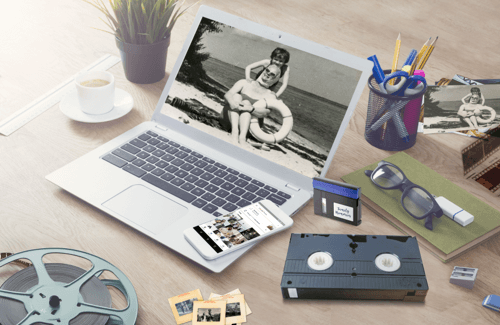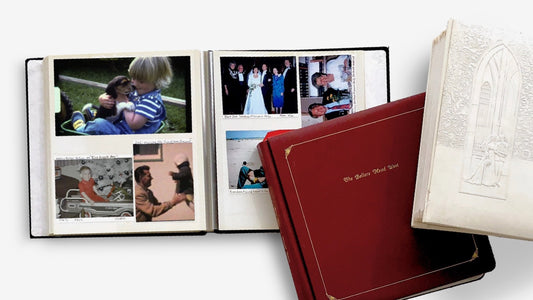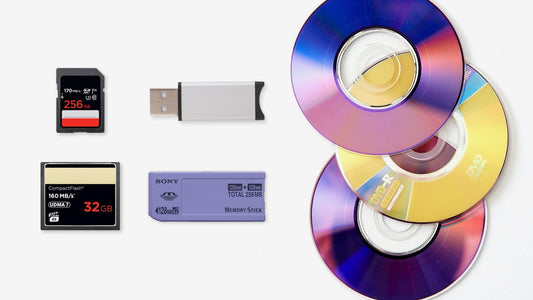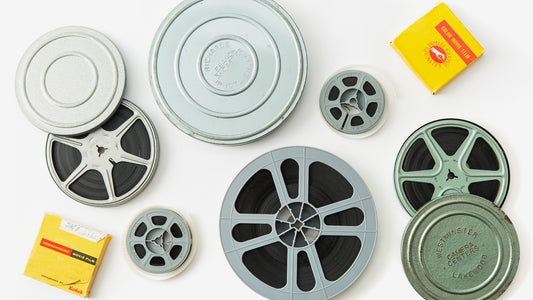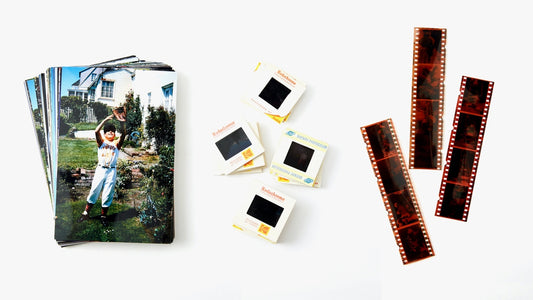Your VHS tapes are in a race against time. The magnetic tape they’re made of is fragile and degrades with each passing year, vulnerable to heat, humidity, and simple decay. Every moment those memories sit in a box, they risk fading away forever. The only way to stop this process is to digitize them. Creating a digital copy preserves your home movies in a stable format that won’t wear out. This guide provides the urgent and practical steps you need to transfer VHS to computer, saving your family’s most important moments before they’re lost. It’s the ultimate backup plan for your history.
Key Takeaways
- Gather the Right Gear for a Clear Connection: To transfer tapes yourself, you'll need a working VCR, a video capture device to act as a bridge, and the right cables to connect them to your computer. A solid setup is the foundation for a quality transfer.
- Choose MP4 for Easy Sharing and Back Up Everything: Save your digitized videos as MP4 files for the best compatibility across all devices. Always create at least two copies of your final files—one on an external hard drive and another in the cloud—to protect them from being lost.
- Assess Your Time and Tech Skills to Choose Your Path: A DIY project offers total control but requires a significant time investment and troubleshooting. If you have many tapes or prefer a hands-off approach, a professional service ensures high-quality results without the hassle.
What Equipment Do You Need to Transfer VHS Tapes?
Ready to bring your home movies into the digital age? The first step is gathering the right equipment. Think of it like setting up a mini-production studio right in your living room. You'll be bridging the gap between the analog world of VHS and the digital world of your computer, and while it might sound technical, it's totally manageable once you have the key pieces. This guide will walk you through exactly what you need to get started on your digitization project.
The main challenge is finding hardware that can communicate between your old tapes and your modern computer. Since VCRs aren't exactly flying off the shelves anymore, this part can feel like a bit of a scavenger hunt. But with a little patience, you can find everything you need to digitize those precious memories yourself. It’s a rewarding project that puts you in complete control of preserving your family’s history. If sourcing and setting up the gear feels like too much of a hurdle, remember that professional video transfer services exist to take care of everything for you, ensuring your memories are handled with care from start to finish. This DIY approach requires a specific set of tools, so let's break down exactly what you'll need to pull it off.
The Checklist: VCR, Capture Device, and Cables
First things first, you need the hardware to play your tapes and get the signal to your computer. Here are the three essential items for your checklist:
- VCR: This is non-negotiable. You need a working Video Cassette Recorder to play your VHS tapes. If you don't have one stashed in the attic, you can often find them at thrift stores, online marketplaces, or maybe even a relative's garage.
- Video Capture Device: This small but mighty gadget is the translator. It converts the analog video signal from your VCR into a digital format your computer can read.
- Cables: You'll need either RCA cables (the ones with red, white, and yellow plugs) or an S-Video cable to connect your VCR's output to the capture device's input.
Computer and Software Requirements
Once you have the hardware to play and convert your tapes, you need the digital tools to record and save them. This part of the setup involves your computer and some specific software.
- A Computer: You’ll need a Mac or a PC to run the software and store your newly digitized video files. Make sure you have enough free hard drive space, as video files can be quite large.
- Recording Software: Most video capture devices come with their own software, which is usually the easiest option to get started. If yours doesn't, or if you want more control, free programs like Open Broadcaster Software (OBS) are excellent alternatives for recording the video feed from your VCR.
How to Set Up Your Equipment
Okay, you've gathered all your gear. Now comes the part where we put it all together. It might look like a tangle of wires, but I promise it's more straightforward than it seems. We'll walk through it step-by-step, from connecting your VCR to making sure your computer is ready to capture those memories. Taking a few minutes to get this right will save you a lot of headaches later and ensure you get the best possible quality from your old tapes. Let's get everything hooked up.
Connect Your VCR to the Capture Device
First things first, let's get the video signal from your VCR to your capture device. Grab your cables. You’ll need to connect the RCA or S-Video cables from the 'output' ports on your VCR to the corresponding 'input' ports on the capture device. If you're using the standard red, white, and yellow RCA cables, just match the colors. Yellow is for video, while red and white handle the audio. For slightly better video quality, you can use an S-Video cable if both your VCR and capture device have the port, but you'll still need the red and white cables for sound. Making sure everything is plugged in snugly is key to getting a clean signal.
Link the Capture Device to Your Computer
With your VCR and capture device talking to each other, the next step is to bring your computer into the mix. This part is usually the easiest. Simply plug the USB side of the converter into an open USB port on your computer. I always suggest plugging it directly into the computer itself, rather than a USB hub, to ensure a stable connection and prevent any drops in quality during the transfer. Your computer should automatically recognize the new hardware, getting you one step closer to digitizing your tapes. If you run into any issues, sometimes just trying a different USB port can solve the problem.
Install and Configure the Software
Your capture device needs software to work its magic. Most converters come with an installation disc, but if your computer doesn't have a disc drive, don't worry. You can typically download the software right from the manufacturer’s website. Go ahead and install the software that came with your converter by following the on-screen instructions. Once it’s installed, open the program. You’ll likely need to go into the settings or preferences menu and select your USB capture device as the video and audio source. This tells the software where to find the incoming signal from your VCR.
Test Your Connections Before You Record
Before you hit record on your most precious memories, it’s smart to do a quick test run. This final check ensures everything is working correctly and can save you from re-doing the whole process. First, it’s a great idea to clean your VCR heads to prevent any static or fuzzy spots in your video. Then, pop in a test tape—not your wedding video!—and press play. You should see the video playing in the software’s preview window on your computer. Make sure you can hear the audio, too. If everything looks and sounds good, you’re all set to start recording for real.
How to Record Your VHS Tapes, Step by Step
This is the exciting part—where your old home movies start their journey to becoming digital memories. With your equipment all set up and connected, you're ready to hit record. This process is done in real-time, meaning a two-hour tape will take two hours to transfer, so grab a cup of coffee and get comfortable. Following these steps carefully will ensure you get the best possible quality from your tapes and create a digital file you can cherish for years. If the process feels a bit overwhelming, remember that professional video transfer services can handle all the technical details for you. But if you're ready to tackle it yourself, let's get started.
Prepare Your Tape and Equipment
Before you press play, take a moment to prepare. First, inspect your VHS tape for any visible damage, like a tangled or torn ribbon. Gently wind the tape to make sure it's taut. Once your tape is ready, double-check your connections. The RCA or S-Video cables should run from the "output" ports on your VCR to the "input" ports on your capture device. Then, make sure the USB cable from the capture device is securely plugged into your computer. A solid connection is key to a smooth transfer, so it's worth taking an extra minute to confirm everything is in its place.
Start the Software and Adjust Settings
Now, open the video capture software that came with your device. The first thing you'll need to do is tell the software where to look for the video signal. In the settings or preferences menu, select your capture device as the input source. Next, you'll want to adjust the recording settings. This is where you can choose the video quality—higher quality means a larger file size. You should also select a destination folder on your computer where the final video file will be saved. Getting these settings right before you start recording will save you a lot of time later.
Record Your Video from Start to Finish
This is the moment of truth. In your capture software, you should see a "Record" button. Click it first. Then, immediately press the "Play" button on your VCR. The video from your tape should now appear on your computer screen as it records. It's important to let the entire tape play through without interruption to capture every moment. Once the tape finishes playing and the screen goes to static or blue, press the "Stop" button in your software. That's it—you've successfully captured the raw footage from your VHS tape!
Monitor and Finalize the Transfer
While the tape is recording, it's a good idea to keep an eye on the process. Watch the video on your computer screen to make sure the picture and sound are coming through clearly. This helps you catch any issues, like a tracking problem on the VCR, as they happen. Once you've stopped the recording, the software will prompt you to name and save your new digital file. Give it a descriptive name, like "FamilyChristmas1995," so you can easily find it later. Your video is now saved and ready for editing, sharing, or backing up.
Choosing the Best File Format for Your Videos
Once your VHS tape is digitized, you need to save it as a digital file. Think of a file format as the container that holds your video. The format you choose affects the video's quality, how much storage space it takes up, and what devices you can play it on. It’s a bit of a balancing act between getting the best possible picture and having a file that’s easy to store, share, and watch for years to come.
For most of us, the goal is to preserve our memories in a format that our kids and grandkids can easily open without needing special software. You want something that plays on your phone, your laptop, and your smart TV. While there are dozens of video formats out there, most people will be choosing between a few common options. Let's walk through the most popular ones so you can feel confident picking the right container for your precious memories.
The Benefits of MP4
If you’re looking for the MVP of video formats, it’s MP4. This is the go-to format for a reason. Opting for a high-definition MP4 offers incredible compatibility and versatility. It’s like the universal language of video files—it plays nicely with just about every device, platform, and software out there, from iPhones and Androids to Windows and Macs.
Because MP4 files are compressed, they strike the perfect balance between great quality and manageable file size. This means you can store more videos without filling up your hard drive, and they’re small enough to easily email to your sister or upload to Facebook for the whole family to enjoy. For most people looking to transfer their home movies, MP4 is the simplest, most reliable choice.
When to Use MOV
The MOV format was created by Apple, so if you’re a dedicated Mac user, you’re probably already familiar with it. It’s the default format for QuickTime Player and is known for maintaining very high quality, which makes it a favorite among video editors. If you plan on doing some serious editing to your home movies in a program like Final Cut Pro, MOV can be a great option.
However, its Apple-centric roots mean it isn’t quite as universal as MP4. While many non-Apple devices and programs can play MOV files now, you might occasionally run into compatibility issues. It’s a fantastic format for quality, but for simple sharing and long-term viewing, you might find MP4 to be a little more straightforward and worry-free.
What About AVI?
AVI is one of the older video formats, developed by Microsoft back in the day. Its main claim to fame is its ability to store video with very little or no compression. An uncompressed AVI file is the very best for videos that are historical and priceless because it preserves the footage in its purest form. Think of it as a perfect, lossless digital copy of your original tape.
The catch? That incredible quality comes at a cost. Uncompressed AVI files are enormous and will eat up your storage space at a terrific rate. A single tape could take up a huge chunk of your hard drive. This format is really best for professional archivists or those who prioritize perfect preservation above all else and have unlimited storage to work with.
How to Pick the Right Format for You
So, how do you choose? It really comes down to what you plan to do with your videos. For 99% of families, MP4 is the clear winner. It gives you beautiful quality in a file size that’s perfect for storing, sharing, and watching on any device you own. It’s the most future-proof and hassle-free option for enjoying your memories.
If you’re a video editing enthusiast working on a Mac, MOV is a solid choice. And if you’re a serious archivist who wants a mathematically perfect copy of your tape and has tons of storage, you might consider AVI. Professional archivists often use uncompressed video streams for preservation. But for reliving family vacations and birthdays, a simple, universal format is best. A professional video transfer service can make this easy by providing your memories in a ready-to-watch format.
How to Edit and Improve Your Digitized Videos
Once you’ve successfully transferred your VHS tapes to your computer, the real fun begins. This is your chance to take that raw footage and turn it into a polished movie that your family will want to watch over and over again. You don’t need to be a professional video editor to make a huge difference. Simple adjustments can fix faded colors, remove awkward pauses, and organize scattered clips into a cohesive story that truly captures the spirit of the moment. It’s less about technical skill and more about curating your family’s history.
Think of this process as creating a highlight reel of your family’s best moments. You can trim away the boring parts (like the five minutes of someone’s shoes while the camera was still recording) and focus on the memories that matter most. Adding simple titles, a bit of music, or some basic color correction can breathe new life into decades-old footage. It’s a wonderful way to honor your memories and make them more accessible and enjoyable for a new generation. This is how you transform a dusty box of tapes in the attic into a treasured family movie night, ready to be shared and relived. It’s the final, creative step in bringing your history into the present, ensuring these moments aren't just saved, but celebrated.
Find the Right Editing Software
You don’t need to invest in expensive, complicated software to edit your home movies. Chances are, you already have everything you need. If you’re using a Mac, iMovie is a fantastic, user-friendly option that comes pre-installed. For Windows users, the Photos app has a built-in video editor that handles basic tasks well. For a bit more creative control, you can use a free and powerful tool like CapCut, which offers easy-to-use templates, music, and effects. The key is to choose a program that feels intuitive to you, so you can focus on the creative side of things without getting stuck on technical details.
Improve Video Quality and Correct Color
VHS tapes naturally lose some of their color and clarity over time, often leaving them with a faded or yellowish tint. Most editing software includes basic color correction tools that can make a world of difference. Look for settings like brightness, contrast, and saturation. A small increase in saturation can make colors pop, while adjusting the brightness can reveal details that were lost in the shadows. Don’t be afraid to experiment with these settings. You can often see the changes in real-time and undo them if you don’t like the result. The goal is to make the video look more true to life, just as you remember it.
Add Titles and Organize Your Clips
Adding simple text overlays or title cards is one of the easiest ways to give your home movie a professional touch. You can add a title at the beginning, like “The Miller Family: Summer of 1995,” or use text to identify people, places, and events throughout the video. This provides helpful context, especially for younger family members who weren’t there. This is also a great time to organize your clips. If you’ve digitized multiple tapes, you can drag and drop the clips into chronological order or group them by event, like birthdays or holidays, to create a more compelling story.
Trim and Split Your Footage
A typical home video has plenty of footage that isn’t essential—the first few seconds of static, the shaky camera work, or the moments when the camera was pointed at the ground. Use the trim or split tool in your editing software to cut these parts out. This simple cleanup makes your videos much more watchable. You can also split a long two-hour tape into several shorter videos based on the events they capture. A 10-minute video of a birthday party is much easier to share with family than a single, massive file. Once you’re done, save your final video as an MP4 for easy sharing and viewing.
Common Mistakes to Avoid When Transferring VHS Tapes
Transferring your old VHS tapes is a fantastic way to preserve your family’s history, but the process has a few potential snags. When you’re dealing with irreplaceable memories, you want to get it right the first time. A few common missteps can lead to poor-quality video, lost files, or a lot of wasted time. By knowing what to look out for, you can make sure your home movies look their best for years to come. Let’s walk through some of the most frequent mistakes and how you can sidestep them.
Equipment and Setup Pitfalls
Before you even press play, your equipment setup can make or break your project. One of the most overlooked steps is cleaning the VCR heads. Over time, dust and tape residue build up, which can cause a snowy, distorted, or blurry picture during playback. Using a simple head-cleaning cassette can clear up the image significantly. It’s also important to double-check that all your cables are securely connected and that your capture device is compatible with your computer. A loose connection can interrupt the recording and force you to start all over again.
File Format and Storage Errors
Once the video is on your computer, what you do with it matters just as much. Choosing the wrong file format can limit how you can watch, edit, and share your memories. While it might seem easy to burn your videos directly to a DVD, this can be a mistake. DVDs can degrade over time, and they lock your video into a format that’s difficult to edit or upload online. Instead, save your videos as a versatile file type like MP4 directly to your computer’s hard drive. This gives you the flexibility to make copies, edit clips, and share them easily with family.
Losing Video Quality
The goal of any video transfer is to preserve the original quality as much as possible, but cheap equipment can work against you. The analog-to-digital converter is the most critical piece of hardware in this process, acting as the bridge from your VCR to your computer. Using a low-quality capture device can result in a significant loss of detail, poor color accuracy, and audio that’s out of sync. While it might be tempting to buy the cheapest option available, investing in a reliable, well-reviewed converter will pay off in the final result, ensuring your digitized memories are clear and watchable.
Forgetting to Back Up and Organize
You’ve successfully transferred your tape, and the file is sitting on your desktop—you’re done, right? Not quite. Forgetting to back up your new digital files is one of the biggest risks you can take. A single hard drive failure could mean losing those precious memories forever. A good rule of thumb is to keep at least two copies: one on an external hard drive and another on a cloud storage service. It’s also a great idea to take a few minutes to name and organize your files. A folder labeled "1995 Family Christmas" is much easier to find later than a generic file name like "capture_01.mp4."
DIY vs. a Professional Service: Which Is Right for You?
When it comes to digitizing your VHS tapes, you have two main paths: you can tackle it yourself or hand it over to the pros. There’s no single right answer—the best choice really depends on your technical skills, how much time you have, and the size of your tape collection. Let's walk through the specifics of each option so you can figure out what makes the most sense for you and your precious memories.
The Pros and Cons of DIY
Going the DIY route gives you complete control over the entire process. You get to pick the final file format, manage the quality, and organize the digital files exactly how you want them. For anyone who enjoys a hands-on project and has a bit of technical know-how, it can be a really satisfying experience. However, the trade-off is a significant investment of time and money. You’ll need to buy specific equipment, like a working VCR and a capture device, and the costs can add up. Plus, remember that a two-hour tape will take at least two hours to record, not counting setup, troubleshooting, or editing time.
The Benefits of Using a Service
Using a professional service is by far the easiest and most convenient way to digitize your tapes. You simply pack them up and let experts handle the rest. Companies that specialize in this have professional-grade equipment that can often yield higher-quality results than a home setup. They take care of all the technical heavy lifting, so you don't have to worry about software compatibility or file conversions. If you have a large collection of tapes or just don't feel confident managing the technology, a video transfer service is a fantastic, stress-free option that ensures your memories are preserved safely and correctly.
How to Decide
To find your answer, think about a few key factors. First, how many tapes are you working with? If it’s just one or two, a DIY project might be manageable. But if you have a box full of them, the time commitment can quickly become overwhelming. Next, consider your budget. Price out the necessary DIY equipment and compare that to the cost of a professional service for your collection. Finally, be honest about your available time and technical comfort level. If the idea of connecting cables and configuring software feels daunting, a professional service will save you a lot of potential frustration.
How to Store and Share Your Digitized Memories
Once you’ve successfully transferred your VHS tapes to your computer, the next step is just as important: making sure those precious memories are safe, organized, and easy to share. Unlike bulky tapes that degrade over time, digital files can last forever if you handle them correctly. The best part is that you can finally share that hilarious family vacation video from the 90s with relatives across the country with just a few clicks. Let’s walk through the best ways to store, back up, and share your newly digitized videos so they can be enjoyed for generations.
Storing and Backing Up Your Videos
Digital files take up much less physical space than tapes, but they can be lost in a flash if your computer crashes. That’s why having a solid backup plan is essential. A good rule of thumb is to keep at least three copies of your files: one on your computer, one on an external storage device, and one in the cloud. For physical backups, an external hard drive or a high-capacity USB drive works perfectly. You can simply drag and drop your video files onto the drive. This gives you a tangible copy you can store in a safe place, like a fireproof box, ensuring your memories are protected no matter what.
Sharing Your Memories with Cloud Storage
Cloud storage services like Google Drive, Dropbox, and iCloud are fantastic for both backing up and sharing your videos. Uploading your files to the cloud creates an off-site backup that you can access from any device with an internet connection. This makes sharing with family and friends incredibly simple—no more mailing fragile DVDs that might not even work in modern computers. You can send a direct link to a video file or create a shared folder where the whole family can view and download the memories. It’s a secure and convenient way to keep everyone connected to those special moments.
Tips for Preserving Your Videos for Years to Come
To keep your digital memories organized, create a simple folder system and give your files clear, descriptive names (e.g., "Family_Reunion_July_1998.mp4"). This will save you from searching through vaguely named files later. Remember, VHS tapes degrade over time, so it’s best to digitize them as soon as you can to prevent further loss of quality. If the DIY process feels overwhelming, a professional video transfer service can handle the entire process for you, delivering high-quality digital files that are ready to store and share. It’s a great option for ensuring your memories are preserved perfectly.
Related Articles
- VHS Tape to Digital: The Ultimate 2024 Guide – YesVideo
- Best VHS Video to Digital Converters: Top Picks – YesVideo
- Convert VHS to Digital: The Ultimate 2024 Guide – YesVideo
Frequently Asked Questions
What if I can't find a working VCR? This is probably the most common hurdle! Since VCRs aren't made anymore, it can feel like a bit of a treasure hunt. Your best bets are thrift stores, online marketplaces like eBay or Facebook Marketplace, or simply asking older relatives if they have one tucked away in a closet. If the search becomes too frustrating or you're worried about the quality of a used machine, this is often the point where a professional service becomes a great, stress-free alternative.
How much storage space will I actually need on my computer? It's smart to plan for this before you start, because video files are quite large. As a general rule, you can expect one hour of digitized video to take up about 13 gigabytes of space. I recommend saving your files to an external hard drive rather than your computer's main drive. This keeps your computer from getting bogged down and makes it easy to store and back up your entire collection in one place.
Why is saving my video as an MP4 file better than burning it to a DVD? Think of it in terms of flexibility and longevity. DVDs can get scratched, suffer from "disc rot," and degrade over time, just like the tapes you're trying to preserve. Plus, many modern laptops and computers don't even have disc drives anymore. An MP4 file, on the other hand, is a universal format that you can easily copy, edit, upload to the cloud, and share with anyone on any device. It’s a much more future-proof way to protect your memories.
Can I really improve the quality of a very old, fuzzy tape? You can't turn a standard-definition home movie into a 4K masterpiece, but you can absolutely make it look better. The process starts with getting the best possible signal from the tape, which means cleaning your VCR's heads is a crucial first step. From there, simple adjustments in editing software to correct faded colors and improve brightness can make a huge difference, often making the video look much more vibrant and clear than it does playing straight from the VCR.
If I'm on a budget, what's the one piece of gear I shouldn't skimp on? The single most important piece of your setup is the video capture device. This is the gadget that does all the work of converting the analog signal from your VCR into a digital file your computer can read. A cheap, low-quality converter can introduce problems like a blurry picture, inaccurate colors, or audio that's out of sync with the video. Investing in a reliable, well-reviewed capture device will have the biggest impact on the final quality of your home movies.





